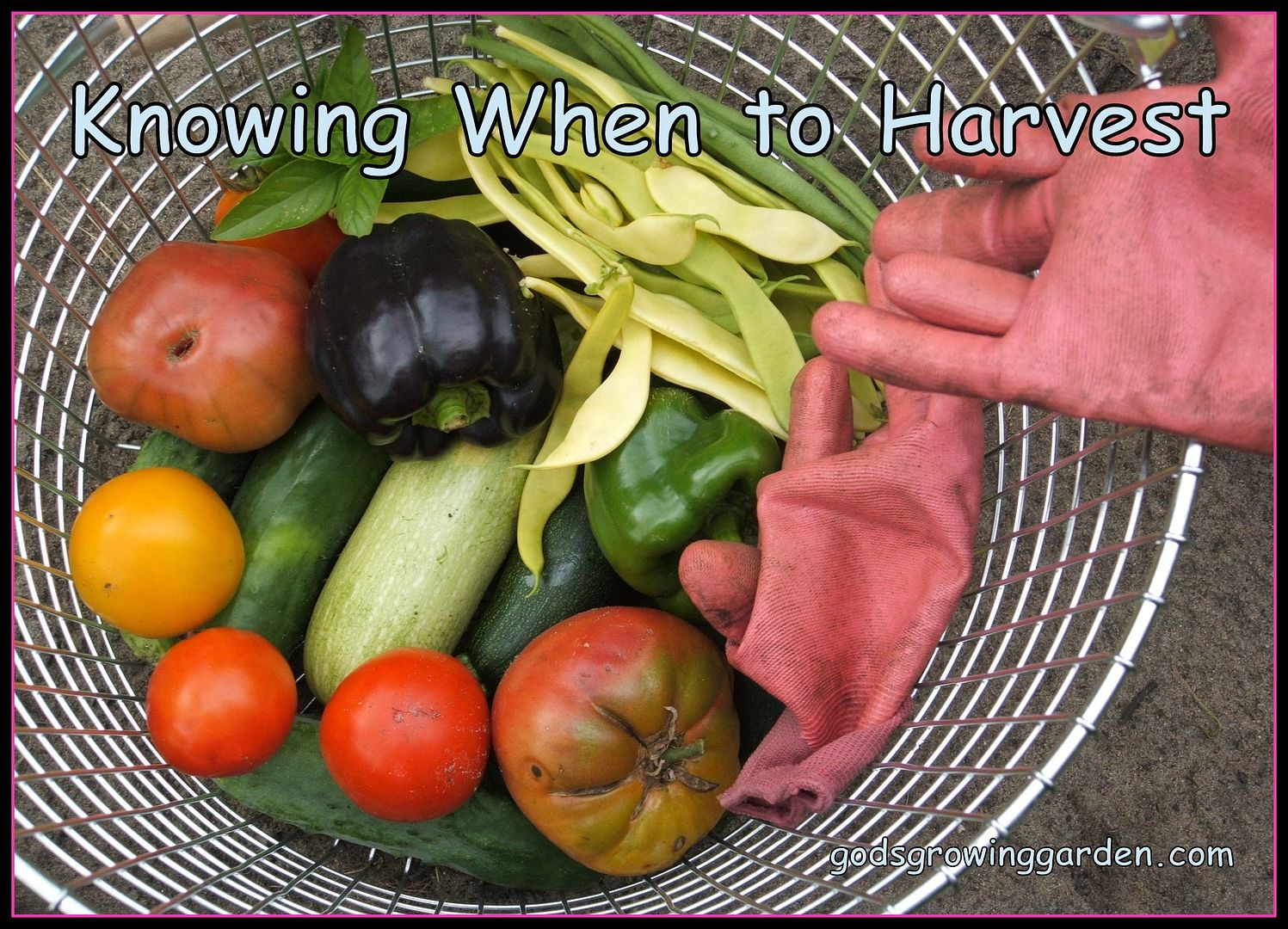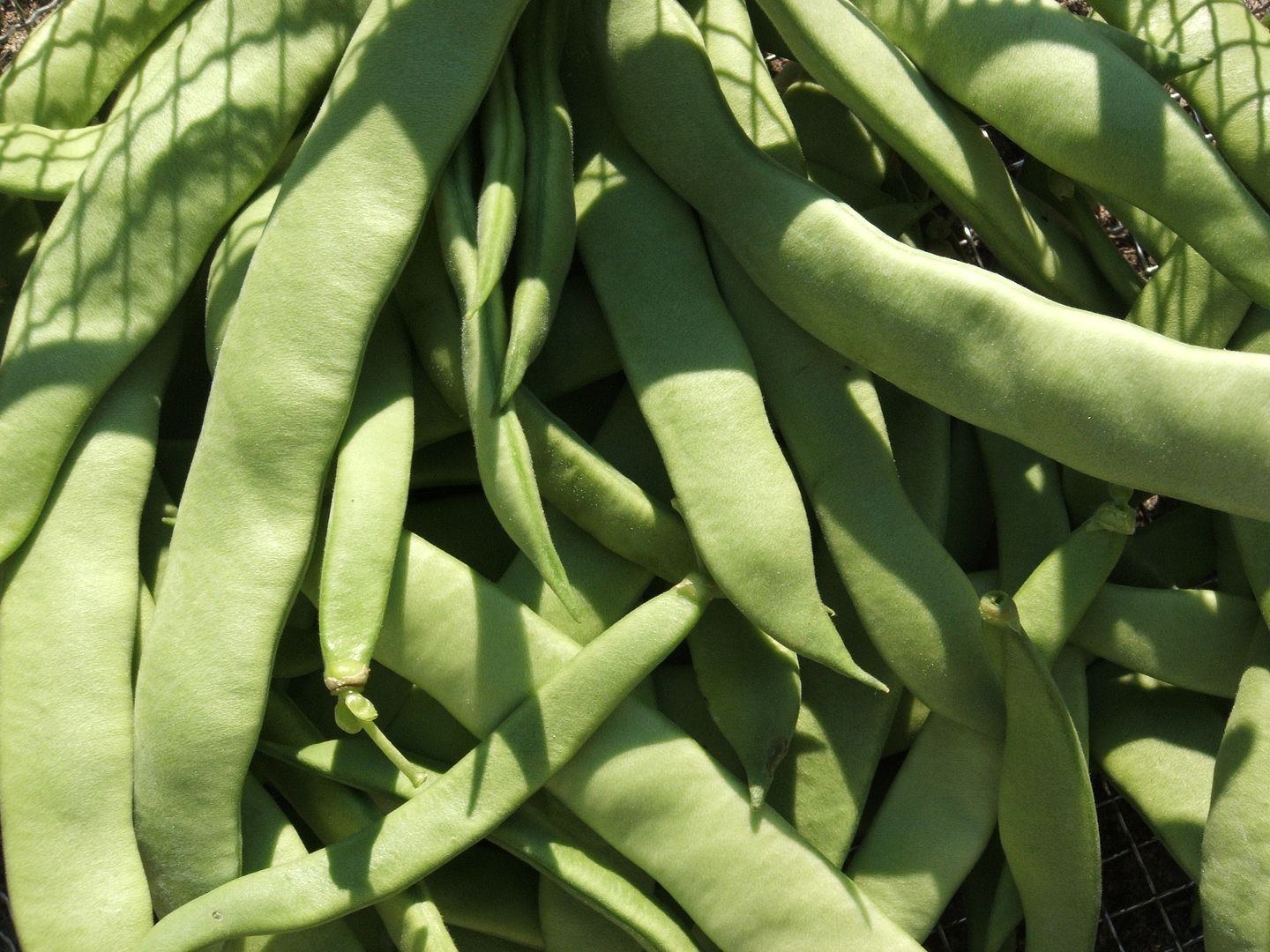Angie from God's Growing Garden is sharing with us today.

We had a great garden season and it looks like harvest season is going to be wonderful also! Tthis post is my 18th "Contributing Angel" post (Thank you again to my friend Angel for allowing me to contribute to your amazing blog!)
If you are new to gardening or even if you are a seasoned pro - it's always good to go back to basics - below are the 4 basic signs to knowing when to harvest.

1. Timing
Know what you planted and know the timing of each variety. Let's use green beans as an example - on the back of the seed packet you will see something like: "60 day green beans" or "45 day beans" - it will tell you the estimated time that it will take until harvest time. (click HERE for some great bean ideas). This is helpful not only to know when to plant your seeds but also to know when to start looking for fully grown produce.
There are other variables involved in timing like weather. Not every year will your beans be ready for picking on the exact date or by the exact timing on the packet because it might have been a dry weather year and that will throw that timing off by a week or so. You may also want to use some of the other signs also in "knowing when to harvest". (If you are a new gardener, I suggest placing a star on your calendar & the name of the vegetable on the date that you estimate harvest to begin).

2. Color
Color is the next best way to know when to harvest. Again, you must know what you planted! Take tomatoes as an example - I grew many different varieties of tomatoes & they are all different colors. The yellow orange low acid tomato and a black variety (which actually ripens when it is a deep dark burgundy) and a striped Roma. Color will not always help with everything that you grow - like green beans - they will always be green - just know what you are growing.
(click HERE for some great tomato ideas).

3. Size
Size is another great way to know when to harvest. Zucchini is a perfect example of a vegetable that can be harvested at almost any size. You pick zucchini by your size preference. When I am making a salad I always pick a small tender zucchini to cut up and eat raw on top of my salad (see the left picture above). Then, if I am baking zucchini bread I will shred a larger zucchini (see right picture above) (click HERE for some great zucchini ideas). Again, know what you are growing to know if it can be harvested at many different sizes.

We had a great garden season and it looks like harvest season is going to be wonderful also! Tthis post is my 18th "Contributing Angel" post (Thank you again to my friend Angel for allowing me to contribute to your amazing blog!)
If you are new to gardening or even if you are a seasoned pro - it's always good to go back to basics - below are the 4 basic signs to knowing when to harvest.

1. Timing
Know what you planted and know the timing of each variety. Let's use green beans as an example - on the back of the seed packet you will see something like: "60 day green beans" or "45 day beans" - it will tell you the estimated time that it will take until harvest time. (click HERE for some great bean ideas). This is helpful not only to know when to plant your seeds but also to know when to start looking for fully grown produce.
There are other variables involved in timing like weather. Not every year will your beans be ready for picking on the exact date or by the exact timing on the packet because it might have been a dry weather year and that will throw that timing off by a week or so. You may also want to use some of the other signs also in "knowing when to harvest". (If you are a new gardener, I suggest placing a star on your calendar & the name of the vegetable on the date that you estimate harvest to begin).

2. Color
Color is the next best way to know when to harvest. Again, you must know what you planted! Take tomatoes as an example - I grew many different varieties of tomatoes & they are all different colors. The yellow orange low acid tomato and a black variety (which actually ripens when it is a deep dark burgundy) and a striped Roma. Color will not always help with everything that you grow - like green beans - they will always be green - just know what you are growing.
(click HERE for some great tomato ideas).

3. Size
Size is another great way to know when to harvest. Zucchini is a perfect example of a vegetable that can be harvested at almost any size. You pick zucchini by your size preference. When I am making a salad I always pick a small tender zucchini to cut up and eat raw on top of my salad (see the left picture above). Then, if I am baking zucchini bread I will shred a larger zucchini (see right picture above) (click HERE for some great zucchini ideas). Again, know what you are growing to know if it can be harvested at many different sizes.
4. Leaves/Stem
The plant leaves or stems are another way to know if your garden produce is ready for harvesting. Look at the left picture above - you will see that I picked a greenish tomato with a green stem and then a perfectly ripe tomato with a brown dried up stem. Also, with squash - the vine and leaves will dry and crumple - that is when it is ready to harvest.
There are some vegetables where this leaf/stem sign is the only clue to know when to harvest and a good example of this is potatoes and sweet potatoes. The plant and leaves will turn brown and become brittle and dry - you will follow that dried up stem to the ground and voila - glorious potatoes! (click HERE to view how to harvest potatoes)
Again, know what you are planting and then look for these harvesting signs.
ENJOY!!




I would like to thank you for the efforts you had made for writing this awesome article.
ReplyDeleteCCTV Camera in Delhi | CCTV Surveillance Camera in Delhi | CCTV Security Camera in Delhi | CCTV Camera Delhi | Delhi CCTV Camera